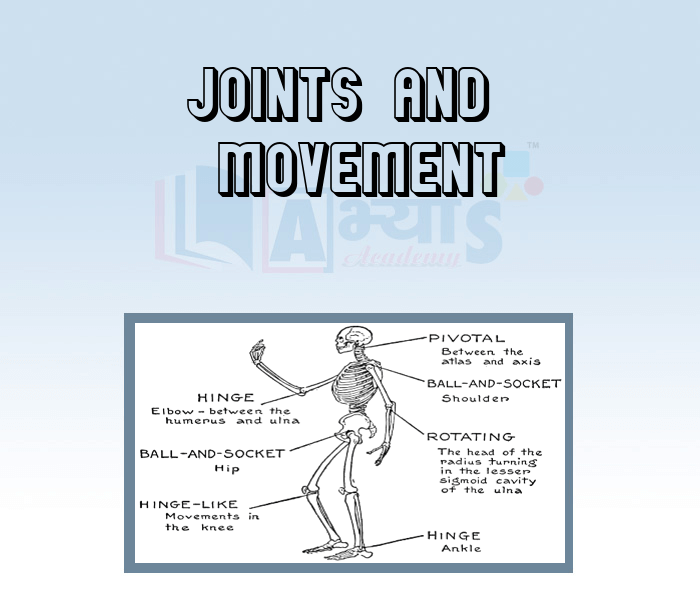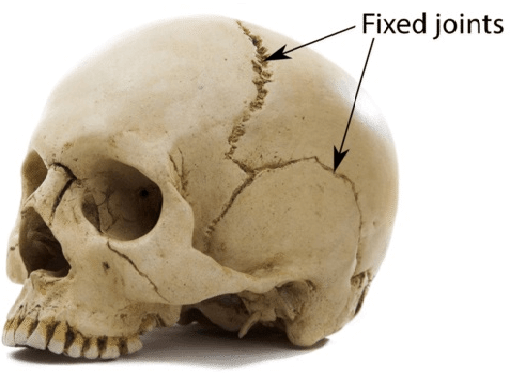Joints And Movement












Joints And Movement
The joints in the body are the places where two bones are joined together. The joints are strong enough to withstand jerks. The ends of bones are covered with soft cartilage. It acts as a shock absorber and reduces friction between the bones. Cartilage is also present in some parts of the body that are not as hard as the bones, for example the upper part of the ear. The bones are held together at the joints by strong, stretchy bands called Ligaments. There are many joints in the body. The joints are of three types, depending on the types of movement they allow—immovable, slightly movable and freely movable.
The bones in the skull (except the lower jaw bone) do not allow any movement. The joints between the ribs and the breast bone allow only slight movement. Most of the joints in the human body are freely movable joints. These freely movable joints are of four main types, depending on the type of movement they allow.
Immovable or fixed joints :
The joints do not allow any movement between the bones. For eg : the bone of skull are interlocked with each other and held together by fibrous cartilage, which do not allow any movement.

Slightly Movable joints:
These joints allow very little movement due to the presence of a pad of flexible cartilage between their ends. For example, joints present between adjacent vertebrae in the backbone or spine allow only slight movement. This kind of joint provides more support.
Freely movable joints :
1. Hinge Joint:
The elbow, knee and finger joints allow movement in one plane only, that is, up and down, or backward and forward, like the hinges of a door. Such joints are therefore called hinge joints. We have hinge joints in our elbows, fingers, knees and toes.

2. Ball and Socket Joint:
The shoulder and hip joints allow movement in all directions. In such joints, the end of one of the bones is round like a ball. It fits into a hollow part (or socket) in the other bone.

3. Pivot Joint:
The neck joint also allows movement in all directions. It allows you to move your head up and down, left and right and also to rotate it. In such joints, one of the bones ends in a rounded or conical surface that fits into a dent in the other bone. Such a joint is called a pivot joint.

4. Gliding Joint:
The wrist or ankle joints have flattened ends of bones that can move ( or glide) against each other, These joints allow side to side as well as backward and forward movement. The vertebrae also have similar joints that allow slight movement. Gliding joints are found between the wrist and the carpals and between the ankle and the tarsals.

The body joints are classified in various types on the basis of | |||
| Right Option : D | |||
| View Explanation |
Which of the following joints is immovable? | |||
| Right Option : C | |||
| View Explanation | |||
The elbow joint | |||
| Right Option : D | |||
| View Explanation |
Students / Parents Reviews [20]
It was good as the experience because as we had come here we had been improved in a such envirnment created here.Extra is taught which is beneficial for future.

Eshan Arora
8thAbhyas institute is one of the best coaching institute in the vicinity of Ambala cantt.The institute provides good and quality education to the students.The teachers are well experienced and are very helpful in solving the problems. The major advantages of the institute is extra classes for weak...

Shreya Shrivastava
8thMy experience with Abhyas academy is very good. I did not think that my every subject coming here will be so strong. The main thing is that the online tests had made me learn here more things.

Hiya Gupta
8thAbhyas Methodology is very good. It is based on according to student and each child manages accordingly to its properly. Methodology has improved the abilities of students to shine them in future.

Manish Kumar
10thIt has a great methodology. Students here can get analysis to their test quickly.We can learn easily through PPTs and the testing methods are good. We know that where we have to practice

Barkha Arora
10thOne of the best institutes to develope a child interest in studies.Provides SST and English knowledge also unlike other institutes. Teachers are co operative and friendly online tests andPPT develope practical knowledge also.

Aman Kumar Shrivastava
10thMy experience with Abhyas Academy has been very good. When I was not in Abhyas whenever teacher ask questions I could not speak it confidently but when I came in Abhyas, my speaking skills developed and now I am the first one to give the answer of teachers question.

Upmanyu Sharma
7thThird consective year,my ward is in Abhyas with nice experience of admin and transport support.Educational standard of the institute recumbent at satisfactory level. One thing would live to bring in notice that last year study books was distributed after half of the session was over,though study ...

Ayan Ghosh
8thMy experience was very good with Abhyas academy. I am studying here from 6th class and I am satisfied by its results in my life. I improved a lot here ahead of school syllabus.

Ayan Ghosh
8thBeing a parent, I saw my daughter improvement in her studies by seeing a good result in all day to day compititive exam TMO, NSO, IEO etc and as well as studies. I have got a fruitful result from my daughter.

Prisha Gupta
8thI have spent a wonderful time in Abhyas academy. It has made my reasoning more apt, English more stronger and Maths an interesting subject for me. It has given me a habbit of self studying

Yatharthi Sharma
10thUsually we see institutes offering objective based learning which usually causes a lag behind in subjective examinations which is the pattern followed by schools. I think it is really a work of planning to make us students grab the advantages of modes of examination, Objective Subjective and Onli...

Anika Saxena
8thThe experience was nice. I studied here for three years and saw a tremendous change in myself. I started liking subjects like English and SST which earlier I ran from. Extra knowledge gave me confidence to overcome competitive exams. One of the best institutes for secondary education.

Aman Kumar Shrivastava
10thAbhyas is a complete education Institute. Here extreme care is taken by teacher with the help of regular exam. Extra classes also conducted by the institute, if the student is weak.

Om Umang
10thAbout Abhyas metholodology the teachers are very nice and hardworking toward students.The Centre Head Mrs Anu Sethi is also a brilliant teacher.Abhyas has taught me how to overcome problems and has always taken my doubts and suppoeted me.

Shreya Shrivastava
8thAbhyas institute is one of the best coaching institute in the vicinity of Ambala Cantt area. The teachers of the institute are well experienced and very helpful in solving the problems of the students.The good thing of the institute is that it is providing extra classes for the students who are w...

Aman Kumar Shrivastava
10thWe started with lot of hope that Abhyas will help in better understnding of complex topics of highers classes. we are not disappointed with the progress our child has made after attending Abhyas. Though need to mention that we expected a lot more. On a scale of 1-10, we would give may be 7.

Manya
8thIn terms of methodology I want to say that institute provides expert guidence and results oriented monitering supplements by requsite study material along with regular tests which help the students to improve their education skills.The techniques of providing education helps the students to asses...

Aman Kumar Shrivastava
10thA marvelous experience with Abhyas. I am glad to share that my ward has achieved more than enough at the Ambala ABHYAS centre. Years have passed on and more and more he has gained. May the centre flourish and develop day by day by the grace of God.

Archit Segal
7thMy experience with Abhyas is very good. I have learnt many things here like vedic maths and reasoning also. Teachers here first take our doubts and then there are assignments to verify our weak points.
